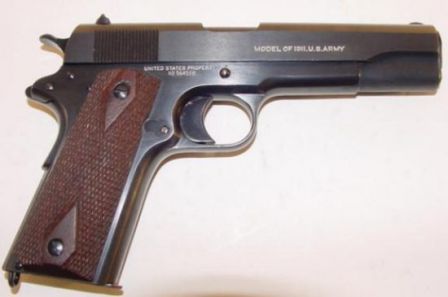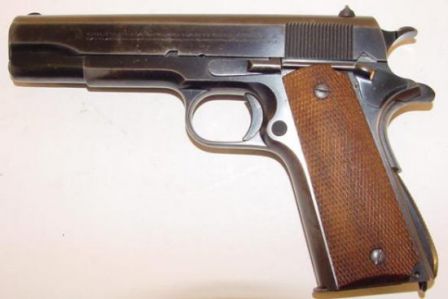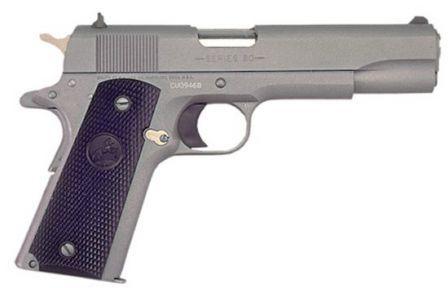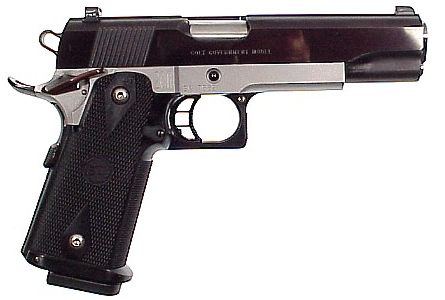U.S. Pistol M1911 made by Colt
U.S. Pistol M1911A1 made by Colt
Differences between M1911 and M1911A1 (see text below)
Colt Government model Series 80 .45ACP
Colt Combat Commander .45ACP
Colt Officers' model .45ACP
Customized Colt Government model Series 80 .45ACP
Custom M1911 clone, made on STI frame and Colt slide .45ACP
Buy SIG-Sauer GSR 1911 pistols at Impact Guns online store
Buy Springfield M1911 pistols at Impact Guns online store
Data: M1911A1
Action: Single
Caliber: .45 ACP
Capacity: 7 Rounds
Barrel Length: 125 mm
Weight: 1080 g
Overall Length: 216 mm
The history of the Colt Gov't / M1911 Pistol began in early 1900s, when
famous designer John M. Browning began to develop semi-automatic
pistols for Colt company. In the 1906-1907 U.S. Army announced trials to
replace its service revolvers with new, semi-automatic pistol. Army
required the new pistol to have the caliber of .45 inch, so Browning
designed its own cartridge that fired 230 grains (14.9 gram) bullet, and
then, designed a new pistol. In 1911, after extensive testings, the new
pistol and its cartridge, designed by Browning and manufactured by
Colt, were adopted for U.S. military service as M1911. Prior to and
during World War One, more than one million of these guns were
manufactured, mostly by Colt and Springfield Armoury, as well as by
Remington-UMC, Burroughs, Savage and some other companies. The rights to
manufacture Colt/Browning design were also sold to some foreign
countries, such as Norway or Argentine.
In 1926, original design was improved, following the recommendations of
the US Army Ordnanve Dept. These changes incorporate the following
items (see picture above):
1. Wider front sight
2. Longer hammer spur
3. Shorter trigger
4. Curved spring housing
5. Simplified grip panels checkering
6. Index finger reliefs behind the trigger
7. Longer grip-safety spur
1. Wider front sight
2. Longer hammer spur
3. Shorter trigger
4. Curved spring housing
5. Simplified grip panels checkering
6. Index finger reliefs behind the trigger
7. Longer grip-safety spur
The improved design was adopted by US Military as M1911A1 pistol, and
served with distinction until the mid-1980s, when it was officially
replaced in service with M9 pistol (US-made Beretta 92FS).
The commercial Colts of this design are known as Government models. In
1929, Colt introduced the Government pistol in its new chambering, the
.38 Super Automatic, a hotter version of the earlier .38 Automatic
cartridge. New pistol had bigger magazine capacity (9 rounds) and sold
well on the police market. The .38 Super versions are still manufactured
and used mostly as competition guns due to extreme accuracy.
During the 1970 - 1983, Colt manufactured Mk.IV series 70 Government
model pistols, which closely resembled original M1911A1s, but with
accurized barrel bushings. Since 1983, Colt manufactured Mk.IV Series 80
Government model pistols, that featured added firing pin safety. Latest
Colt product, M1991A1, also featured Series 80 slide with firing pin
safety.
Colt also developed some more compact versions of its full-size
commercial guns. So called "Commander" versions (available as Combat
Commanders, Lightweight Commanders with alloy frames etc) have shortened
barrels and slides (barrel lenght 108 mm, or 4.25 inch), with the
standart size frame and grip, and standart magazine capacity of 7 rounds
in .45ACP. These guns were also available in .38 Super and 9mm Luger
chamberings. In the year 1972, US Army adopted the M15 General Officers
Model Pistol, developed by Rock Island Arsenal, wery similar to Combat
Commander, as a selfdefence weapon for high level army officers. These
guns had a brass plate insert in the left grip panel, where tha name of
the owner should be engraved.
Even more compact version, the Colt Defender, had also the shorter grip
that limits magazine capacity to 6 rounds of .45ACP. The barrel of
Defender is of 76 mm lenght (3 inch). Commercial Colt Officers' pistols
were also very similar to Defenders.
Along with Colt, countless numbers of companie in the USA and other
countries manufactured more or less exact copies of the M1911. Some
millions of guns were manufactured in the USA during the WW2 by numerous
companies under US Government contracts, and probably even more were
manufactured for commercial sales. Most common M1911 clones are
manufactured by: Springfield armoury, Les Baer, Kimber, Wilson, STI,
Para Ordnance and many, many others. Also, many M1911-partterned pistols
are still custom built for service duty, sport shooting and self
defence.
Technically, the M1911 is a recoil operated, locked breech semi-auto
pistol. It has single action trigger with frame mounted safety that
locks the hammer

and the slide. Hammer could be locked either in cocked or in lowered
position, allowing the gun to be carried in "cocked and locked" state,
with safety on, hammer cocked and round chambered. Additional automated
safety incorporated into rear of the grip and locks the action when gun
not held in the hand properly.
Barrel and slide are interlocked via massive lugs onthe upper part of the barrel, just ahead of the chamber. After the shot is fired, the barrel and the slide go back for the short distance, then rear part of the barrel is lovered by tilting link, and barrel unlocks the slide. The slide goes all the way back, extracting and ejecting spent case and chambering the new round on the way back. When magazine is empty, the magazine follower activates slide stop that locks the slide in the open (rear) position. The gun is fed from the single stack, seven round magazine. The magazine release button is located on the left side of the frame, just behind the triggerguard.
Modern Gov't/1911 clones may differ, more or less, from this description: i.e, those guns may have widebody frames that can accept dual stack, high capacity magazines; frames could be made from steel, alluminium alloys or polymer; some could have Double Action or even Double Action Only triggers, ambidextrous satety switches and slide stops etc.
In the end, i must say that this article is very incomplete, since the Colt Gov't / M1911 is probably the most popular pistol in the world. It is known for its reliability, serviceability, simplicity. Custom made M1911s capable of outstanding accuracy, and many of M1911-patterned guns are still in service with different military and law enforcement agencies in the USA.
Barrel and slide are interlocked via massive lugs onthe upper part of the barrel, just ahead of the chamber. After the shot is fired, the barrel and the slide go back for the short distance, then rear part of the barrel is lovered by tilting link, and barrel unlocks the slide. The slide goes all the way back, extracting and ejecting spent case and chambering the new round on the way back. When magazine is empty, the magazine follower activates slide stop that locks the slide in the open (rear) position. The gun is fed from the single stack, seven round magazine. The magazine release button is located on the left side of the frame, just behind the triggerguard.
Modern Gov't/1911 clones may differ, more or less, from this description: i.e, those guns may have widebody frames that can accept dual stack, high capacity magazines; frames could be made from steel, alluminium alloys or polymer; some could have Double Action or even Double Action Only triggers, ambidextrous satety switches and slide stops etc.
In the end, i must say that this article is very incomplete, since the Colt Gov't / M1911 is probably the most popular pistol in the world. It is known for its reliability, serviceability, simplicity. Custom made M1911s capable of outstanding accuracy, and many of M1911-patterned guns are still in service with different military and law enforcement agencies in the USA.


 18.40
18.40
 Jack The Ripper
Jack The Ripper









 Posted in:
Posted in:
0 komentar:
Posting Komentar